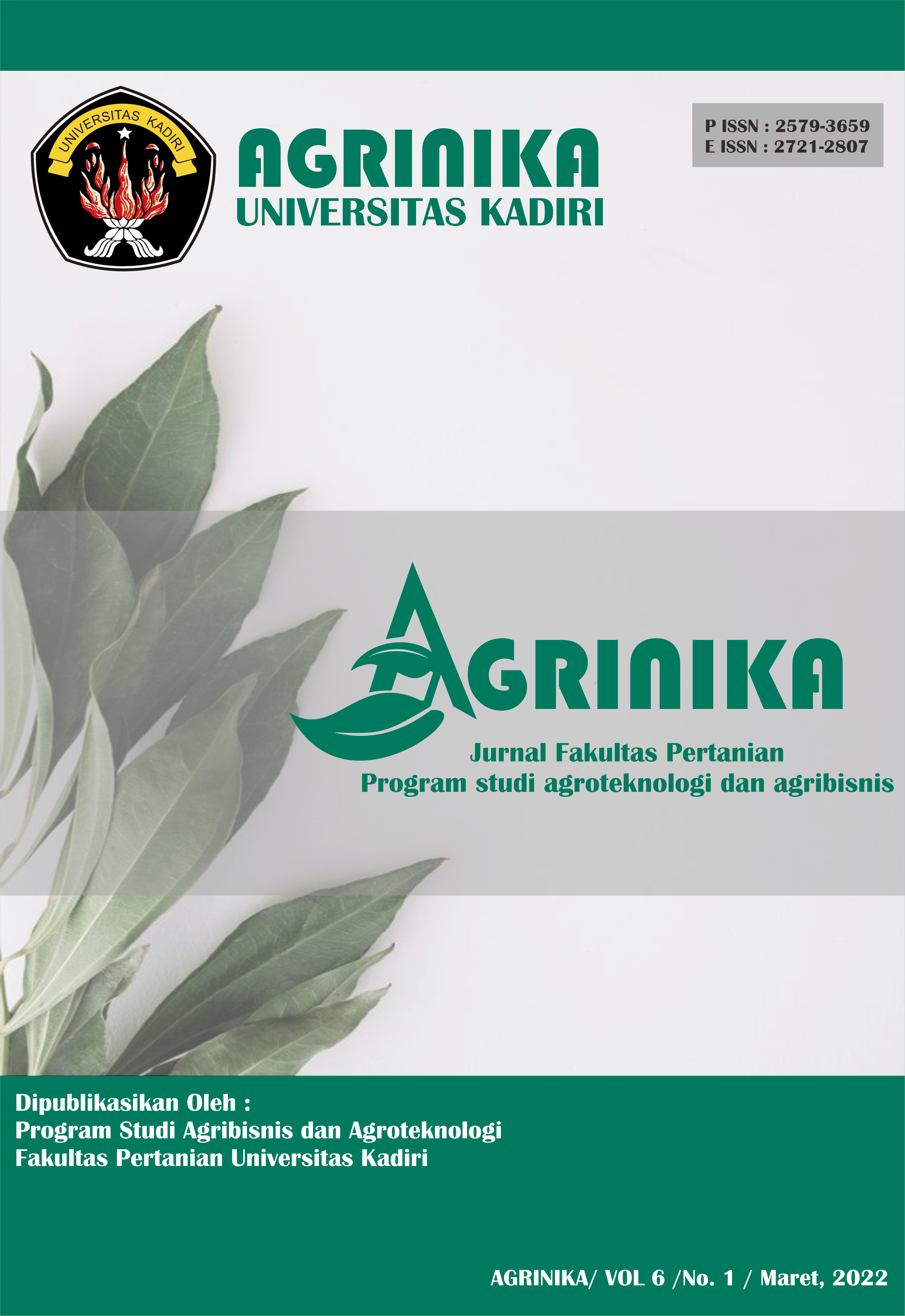Evaluasi Program Pengembangan Usaha Agribisnis Perdesaan (PUAP) di Kabupaten Bondowoso
DOI:
https://doi.org/10.30737/agrinika.v6i1.2051Keywords:
input, outcome, output, processAbstract
This study aimed to evaluate and analyze the effect of the process, input, outcome, and output on the Rural Agribusiness Development Program (RADP) by using regression analysis. The study evaluated the program's implementation in Bondowoso Regency and analyzed its impact on the process, input, outcome, and output indicators. The population in this study was 439 farmers, and 45 people were taken as samples. The results showed that all variables had a significant effect on the program. The output variable was the most dominant variable of all, particularly on the increasing ability and knowledge of the farmers regarding the program. The implementation of program in the Bondowoso Regency had been well implemented. Each indicator had a high level of conformity. The impact of the program's implementation, especially in the Makmur Jaya Farmers' Group, Maesan Village, was successful, where the most dominant indicator was the outcome.Â
Tujuan penelitian ini yaitu mengevaluasi dan menganalisis pengaruh masukan, proses, hasil,  serta keluaran pada program PUAP dengan menerapkan analisis regresi; Melakuan evaluasi penerapan program PUAP di Kabupaten Bondowoso serta melakukan evaluasi dan analisis pengaruh dalam melakukan program PUAP ditinjau dari factor masukan, proses, keluaran dan hasil. Jumlah populasi dalam penelitian ini sebanyak 439 petani dan diambil sampel sejumlah 45 orang. Hasil penelitian menunjukkan. Secara parsial Indikator Input, Process, Output dan Outcome berpengaruh signigfikan terhadap program PUAP di Kabupaten Bondowoso; Secara simultan masukan, proses, keluaran, dan hasil  mempengaruhi program PUAP di Kabupaten Bondowoso; Variabel Output merupakan variable yang paling berpengaruh dominan terhadap program PUAP Bondowoso khususnya pada indikator meningkatnya kemampuan dan pengetahuan petani tentang Program PUAP. Implementasi program PUAP sudah dilaksanakan dengan baik hal tersebut terlihat dari hasil deskriptif pada masing-masing indikator memiliki tingkat kesesuaian yang tinggi. Dampak pelaksnaan PUAP di KAbupaten Bondowoso khusunya di Gapoktan Makmur Jaya dapat dikatakan sangat berhasil, dimana indicator outcoma sebagai indicator yang sangat dominan
References
Badan Pusat Statistik. (2021). Persentase Penduduk Miskin September 2020 Naik. https://www.bps.go.id/pressrelease/2021/02/15/1851/persentase-penduduk- miskin-september-2020-naik-menjadi-10-19-persen.html
Departemen Pertanian. (2008). Monitoring, Evaluasi dan Pelaporan Pengembangan Usaha Agribisnis Perdesaan (PUAP). http://www.deptan.go.id
Departemen Pertanian. (2011). Pedoman Umum PUAP 2011.
Faqih, A., Mutmainah, S., & Wiradinata, R. (2016). EVALUASI MODEL CIPP TERHADAP PELAKSANAAN PROGRAM PENGEMBANGAN USAHA AGRIBISNIS PERDESAAN (PUAP) DI KECAMATAN BABAKAN KABUPATEN CIREBON. Jurnal AGRIJATI, 30(2), 64–71.
Hardiansyah, H. (2014). Evaluasi Program Pengembangan Usaha Agribisnis Perdesaan (PUAP) di Kelurahan Tumbihe Kecamatan Kabila Kabupaten Bone Bolanga. Universitas Gorontalo.
Kaawoan, G. H. (2014). Evaluasi Program Pengembangan Usaha Agribisnis Perdesaan Di Kecamatan Kalawat Kabupaten Minahasa Utara. E-Journal UNSRAT, 1–17.
Mucharam, L., Mustadjab, M. M., & Koestiono, D. (2016). Analisis Dampak Program Pengembangan Usaha Agribisnis Perdesaan ( Puap ) Terhadap Analisis Dampak Program Pengembangan Usaha Agribisnis Perdesaan (PUAP) Terhadap. Bisnis Tani, 2(2), 132–142.
Nugroho, A. D., Waluyati, L. R., & Jamhari, J. (2018). Evaluasi Program Pemberdayaan Usaha Agribisnis Perdesaan (Puap) Di Provinsi Daerah Istimewa Yogyakarta. Jurnal Kawistara, 8(2), 184. https://doi.org/10.22146/kawistara.32086
Sanusi. (2011). Metode Penelitian Bisnis. Salemba Empat.
Sari, W., Yusmini, & Edwina, S. (2016). EVALUASI PELAKSANAAN PROGRAM PENGEMBANGAN USAHA AGRIBISNIS PEDESAAN (PUAP) DI DESA PAGARAN TAPAH KECAMATAN PAGARAN TAPAH DARUSSALAM KABUPATEN ROKAN HULU. JOM Faperta, 3(2), 1–11.
Sawerah, S., Novera, K., & Suyatno, A. (2016). EVALUASI PELAKSANAAN PROGRAM PENGEMBANGAN USAHA AGRIBISNIS PERDESAAN PADA USAHATANI PADI DI DESA SUNGAI DURI II KECAMATAN SUNGAI KUNYIT KABUPATEN PONTIANAK. Jurnal Sains Mahasiswa Pertanian, 1(1).
SPSS 25 for Windows 10. (n.d.).
Sugiyono. (2005). Memahami Penelitian Kualitatif. CV. Alfabeta.
Downloads
Published
Issue
Section
License
Authors who publish in this journal agree to the following terms:
- Authors retain copyright with the work simultaneously licensed under a Creative Commons Attribution License (https://creativecommons.org/licenses/by-nc-nd/4.0/) that allows others to share the work with an acknowledgement of the work's authorship and initial publication in this journal. Permitted third-party reuse is defined by the Creative Commons Attribution-NonCommercial-NoDerivs (CC BY-NC-ND). This permission allows users to copy and distribute the Article, provided this is not done for commercial purposes and further does not permit distribution of the Article if it is changed or edited in any way, and provided the user gives appropriate credit (with a link to the formal publication through the relevant DOI), provides a link to the license, and that the licensor is not represented as endorsing the use made of the work.
- Authors are able to enter into separate, additional contractual arrangements for the non-exclusive distribution of the journal's published version of the work (e.g., post it to an institutional repository or publish it in a book), with an acknowledgement of its initial publication in this journal.
- Authors are permitted and encouraged to post their work online (e.g., in institutional repositories or on their website) prior to and during the submission process, as it can lead to productive exchanges, as well as earlier and greater citation of published work.








